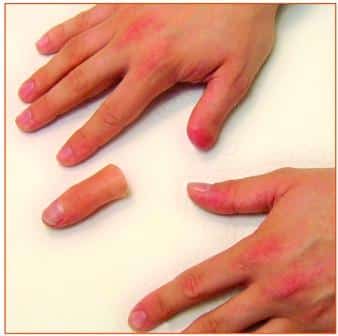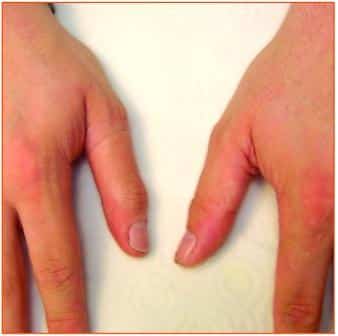Description
An amputation is the removal, by accident or by surgery, of a body part. Amputations in the hand are commonly the result of a traumatic injury but may be the result of a planned operation to prevent the spread of disease in an infected finger or hand. Occasionally, traumatically-amputated fingers may be replanted (reattached).
However, in many cases, reattachment of the amputated finger is not possible or advisable because a person may be more comfortable and have better function if the part is not reattached. This is due to risk that the reattached part could be chronically painful, stiff, and/or have an abnormal or absent feeling.


Amputation Surgery
PRE-SURGERYH
SURGERYh
Sometimes, it is necessary to undergo more than one procedure to maintain maximal length and function of the injured area.
Treatment
THERAPY
Post-amputation, you may be referred to a hand therapist. Therapy will help regain function. Therapy may also reduce pain and abnormal sensation. You’ll likely be given exercises to build your strength. The exercises may help improve your range of motion. Sometimes, a tendon in the amputated finger cannot glide normally. This is usually due to scarring. This may cause you to have trouble bending the fingers that are not injured. It can also affect grip strength. You may be asked to touch and move your skin, which can reduce pain and scarring.
Different splints may be provided after your amputation surgery. Supportive devices such as silicone gel sleeves can cover the neuroma and decrease pain. Guided motor imagery, mirror therapy, joint mobilization, tendon and nerve gliding, and blocking exercises are other types of therapy that may be used. Therapy is necessary to attend with a therapist, and it’s important to work on the exercises several times daily at home.
PROSTHESIS
A prosthesis is an artificial body part that replaces some of the function and appearance of the missing part. The type of your prosthetic hand, finger or arm will depend on the location and length of your remaining finger or hand and your functional and lifestyle needs. It is important to share the activities that you feel are most important with your surgeon and prosthetist so that an appropriate prosthesis can be provided for you after an amputation.
A prosthetic hand or finger can be helpful in many ways and can:
- Restore length to a partially amputated finger
- Enable opposition between the thumb and a finger
- Allow a hand amputee to stabilize and hold objects with bendable fingers
If your hand is amputated through or above the wrist, you may be given a full-arm prosthesis with an electric or mechanical hand. Some amputation patients may decide not to use a prosthesis.
A prosthesis is made from impression casts taken from the remaining finger or limb and the same area on the undamaged hand. This process can create an exact match of the details of the entire hand. The prosthetic hand or finger is made from a flexible, transparent silicone rubber. The colors in the silicone are carefully matched to your skin tones to give the prosthesis the life-like look and texture of real skin. It is usually held on by suction, and the flexibility of the silicone permits good range of motion of the remaining body parts. Fingernails can be individually colored to match almost perfectly. The nails can be polished with any nail polish, and the polish can be removed with a gentle-action nail polish remover. Silicones are resistant to staining, so inks wash off easily with alcohol or soap and warm water.
With proper care, a silicone prosthesis may last 3-5 years. Usually, creation of your prosthesis can begin three months after you are completely healed from amputation surgery and all swelling has subsided. You may need therapy to learn to use your new prosthesis.
RECOVERY
For the first couple of weeks after amputation surgery, you should expect some pain. Pain may be controlled with pain medications, other medication, hand therapy, orthotics (braces or other supports), and other methods such as ice or heat. While you are healing, your doctor will tell you how to bandage and care for the surgical site and when to return to the office for follow-up care.
Amputation involves injury to your nerves. When nerves are cut by trauma or surgery, there may be some long-term symptoms. These symptoms include pain, cold sensitivity, abnormal sensations, or phantom sensation. Phantom sensation occurs when you feel that the absent part is still present. Keep your surgeon up to date. Early treatment of symptoms may work better. If your symptoms are disabling and persistent, they can often be treated with another surgery. For example, you may feel severe pain in a small area. This is caused by a neuroma, an enlarged end of the nerve. This may cause severe pain with light pressure. There are new techniques available that can be helpful for some to relieve neuroma pain.
EMOTIONAL RECOVERY
The loss of a body part, especially one as visible as a finger or hand, can be emotionally upsetting.It may take time to adapt to changes in your appearance and your ability to function after an amputation. Talking about these feelings with your doctor or other patients who have suffered from an amputation often helps you come to terms with your loss. You may ask your doctor to recommend a counselor to assist with this process. It is important to remember that, with time, you will adapt to your situation by finding new ways of doing your daily activities. The Amputee Coalition of America is another helpful resource. These resources can help you to cope with change during recovery. It is vital to remember that quality of life is directly related to attitude and expectations – not just obtaining and using a prosthesis.
Advanced Additiona Reading
Note: This section of amputation is written for a more advanced audience and covers information both on the Quadriga phenomenon and impairment measurements.
The normal anatomy of the human forearm/hand/fingers is characterized by interconnections between the Flexor digitorum profundus (FDP) tendons that flex the terminal joint (DIP joint) of the index, middle, ring, and little fingers.
The FDP muscle acts primarily as a single motor unit to provide coordinated movement of the four FDP tendons to each finger. There can be a relative, but not complete, independence of the muscular part that serves the FDP to the index finger. However, studies have shown that limited motion of any one of the four fingers can limit the active flexion of the other three fingers. This limits not only active motion but subsequently grip strength.
The study of Baaqeel et al. (2017) found that “Splinting of any individual finger resulted in a significant reduction in the TAM (Total Active Motion) of all adjacent fingers, regardless of which finger was splinted (P < .001). Digits immediately adjacent to the splinted finger were more heavily impacted compared with nonadjacent digits. Thus, in the setting of work-related injury, at the end of care an impairment rating may be requested. This rating is intended to quantify any residual impairment after the injury. Since injury to a single finger can impact the motion of other fingers, the impairment ratings which involve limited motion of a finger should also include goniometric range of motion (ROM) of all the other fingers on the same hand so as to determine if there is impairment due to limited active flexion of uninjured fingers on the same hand. When a goniometer is not readily available, this can be grossly estimated in a functional sense by measuring the linear distance between the fingertip and the distal palm crease (DPC) of each finger during vigorous active composite fist. Splinting of the ring finger produced the greatest detriment, with a 26% to 47% reduction in the TAM and a digit to palmar crease distance greater than 40 mm in a third of participants. The index finger caused the least disturbance to remaining digital motion.” This phenomenon has been termed “Quadriga” syndrome/phenomenon/effect. Thus, it is important for the physician, patient, and therapist to not solely focus on the injured finger during rehabilitation but rather optimize all fingers, the hand, and entire limb.
Because of the anatomical structure of the FDP muscle/tendon unit, any condition which limits the proximal excursion of the FDP tendon of one finger can limit the active flexion of the other three fingers of the hand. This limited motion can affect any of the three joints (MP, PIP, DIP) of the finger but especially the DIP joint since only the FDP can flex that joint. Attempts to fully flex uninjured fingers when the FDP tendon of one has limited excursion is often accompanied by strain/pain in the forearm, which in turn can be a deterrent to full action of the other finger flexors (flexor digitorum superficialis, FDS).
Some conditions which have been found to limit proximal excursion of the FDP tendon of a finger include:
- Limited motion of the DIP and/or PIP joints, whether due to joint stiffness, splinting, fear avoidance, or joint fusion
- Transection of the FDP tendon with subsequent scarring, as in some cases of amputation at or proximal to the DIP joint
- Shortening of the FDP tendon of a finger as a consequence of flexor tendon repair or reconstruction
